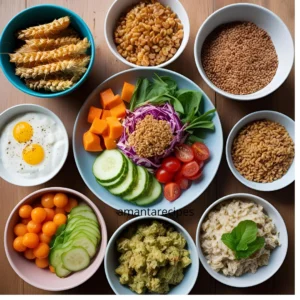Table of contents
Introduction: Are You Tired of Boring Lunches?
Do you find yourself stuck in a lunch rut, eating the same old sandwich or pasta dish every day? What if I told you there’s a way to make your midday meal not only exciting but also packed with energy-boosting nutrients? Enter wheat-free recipes for lunch—specifically, salads that are as delicious as they are nutritious. These five salad recipes will revitalize your afternoons while keeping things gluten-free and easy to prepare.
Overview: Why These Salads Are Special
These lunch salads are designed to be quick, healthy, and versatile. Each recipe takes about 15-20 minutes to prepare, making them perfect for busy weekdays. Plus, they’re beginner-friendly, so even if you’re new to cooking, you’ll have no trouble whipping these up. Packed with fresh veggies, lean proteins, and flavorful dressings, these salads are a powerhouse of vitamins, minerals, and fiber—all while being completely wheat-free.
Essential Ingredients: What Makes These Salads Shine
Every great salad starts with high-quality ingredients. Here’s what you’ll need for these energy-boosting creations:
- Leafy Greens: Spinach, kale, arugula, or romaine lettuce form the base of each salad. They’re rich in antioxidants and keep you feeling full longer.
- Substitutions: Swap greens based on preference; iceberg lettuce works too!
- Lean Proteins: Grilled chicken, boiled eggs, chickpeas, or tofu add staying power to your meal.
- Variations: Use canned tuna or smoked salmon for a seafood twist.
- Colorful Veggies: Bell peppers, cherry tomatoes, cucumbers, carrots, and avocado provide crunch, color, and essential nutrients.
- Tips: Roast some veggies, like sweet potatoes or zucchini, for added depth.
- Healthy Fats: Avocado slices, olive oil, nuts, or seeds bring creaminess and satiety.
- Swaps: If allergic to nuts, try tahini or sunflower seeds instead.
- Flavorful Dressings: Lemon vinaigrette, balsamic glaze, or yogurt-based sauces elevate the taste without adding unnecessary calories.
- DIY Option: Mix olive oil, lemon juice, garlic, salt, and pepper for a simple homemade dressing.
- Optional Extras: Quinoa, brown rice, or gluten-free croutons can bulk up your salad if you’re extra hungry.
Step-by-Step Instructions: How to Prepare These Salads
Let’s dive into the step-by-step process for creating one of these amazing salads (the others follow a similar pattern):
- Prepare Your Base
Wash and dry your leafy greens thoroughly. Place them in a large bowl or on a plate. This is the foundation of your salad. - Cook Your Protein
For example, grill a chicken breast seasoned with salt, pepper, and paprika. Alternatively, boil eggs for 9 minutes, then peel and slice them. - Chop Your Veggies
Dice bell peppers, halve cherry tomatoes, and slice cucumbers. Arrange them neatly over your greens. - Add Healthy Fats
Slice an avocado and sprinkle toasted almonds or pumpkin seeds on top. - Drizzle with Dressing
Pour your favorite dressing lightly over the salad. Avoid drowning it—less is more! - Garnish and Serve
Finish with a dash of fresh herbs like parsley or cilantro for a pop of color and flavor.
Pro Tip: Prep all your ingredients ahead of time and store them separately. Assemble just before serving for maximum freshness.
Assembly: Building Your Perfect Salad
The key to a great salad lies in layering flavors and textures. Start with crisp greens, followed by soft proteins, crunchy veggies, creamy fats, and tangy dressings. Think of it as building a balanced ecosystem on your plate. Play around with colors and shapes to make your salad visually appealing—it’s proven that we eat with our eyes first!
Storage and Make-Ahead Tips
One of the best things about these wheat-free recipes for lunch is their flexibility. Store prepped ingredients in airtight containers in the fridge:
- Greens stay fresh for 2-3 days when stored properly.
- Cooked proteins last up to 4 days.
- Dressings can be made in advance and kept for a week.
When ready to eat, simply assemble your salad and enjoy. For reheating components like roasted veggies or quinoa, use a microwave-safe container and heat for 30 seconds.
Recipe Variations: Get Creative!
Don’t be afraid to mix things up. Here are some fun ideas:
- Add fruit like strawberries, apples, or pomegranate seeds for sweetness.
- Swap out proteins—try shrimp, turkey slices, or black beans.
- Experiment with different grains like millet or buckwheat for variety.
- Go international with toppings like kimchi, feta cheese, or curry-spiced chickpeas.
Conclusion: Energize Your Afternoons with These Salads
With these five wheat-free recipes for lunch, you’ll never dread lunchtime again. Not only are they quick and easy to make, but they’re also customizable to suit your tastes. So grab your apron, head to the kitchen, and experiment with these vibrant, nutrient-packed salads. Your body—and taste buds—will thank you!
FAQs About Wheat-Free Lunch Salads
Q: Can I freeze any of these salads?
A: While freezing isn’t ideal for greens or fresh veggies, cooked proteins and grains can be frozen for future use.
Q: Are these salads kid-friendly?
A: Absolutely! Kids love colorful foods. Let them pick their favorite toppings to get involved.
Q: Do these salads offer enough energy for active lifestyles?
Yes! With protein, healthy fats, and complex carbs, these salads provide sustained energy throughout the day.
Q: Can I make these salads vegan?
Definitely! Substitute animal proteins with plant-based options like chickpeas, lentils, or tempeh.
Q: How do I prevent my salad from getting soggy?
Keep wet ingredients like dressings separate until you’re ready to eat. Also, pat the veggies dry after washin

